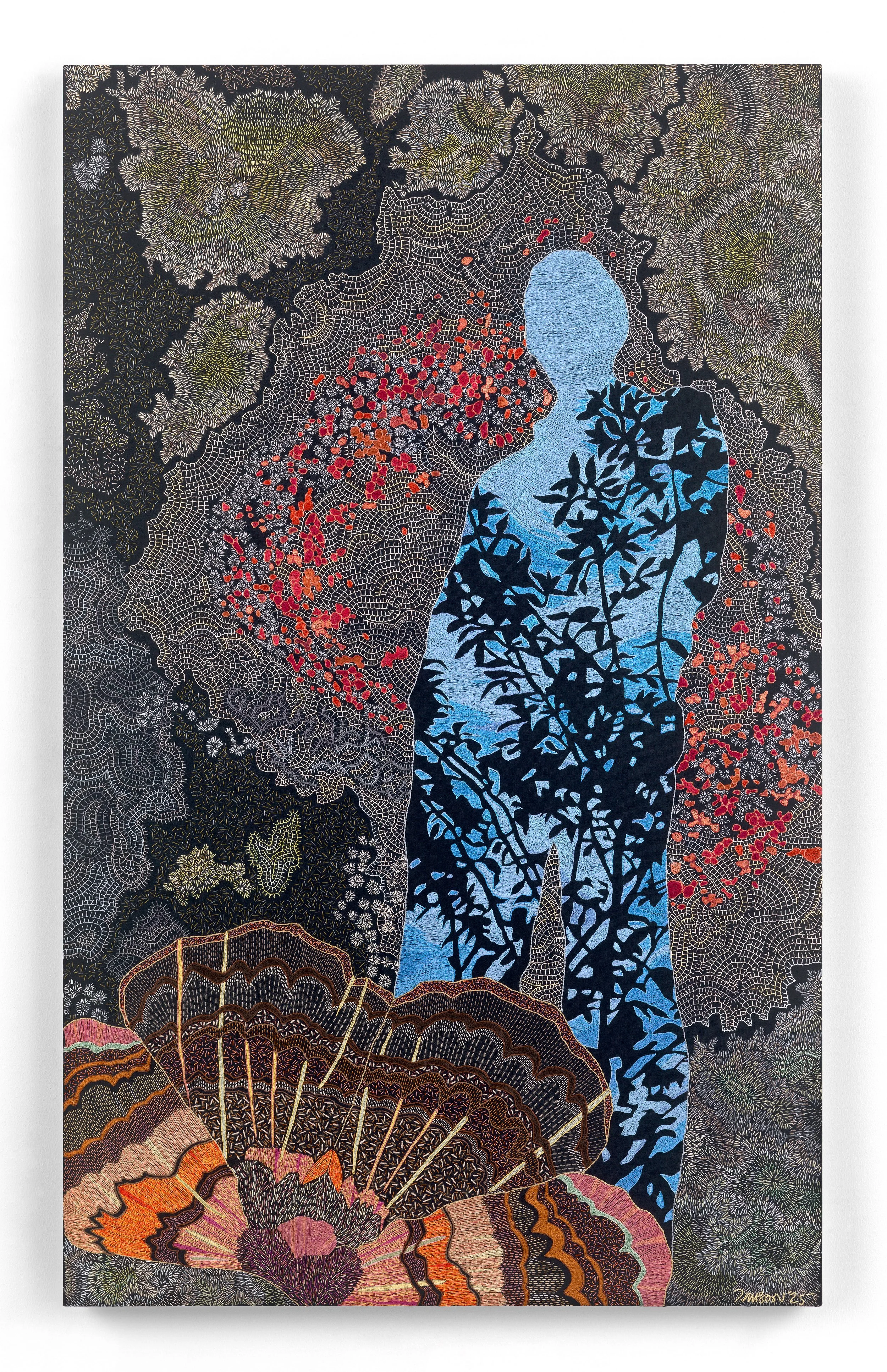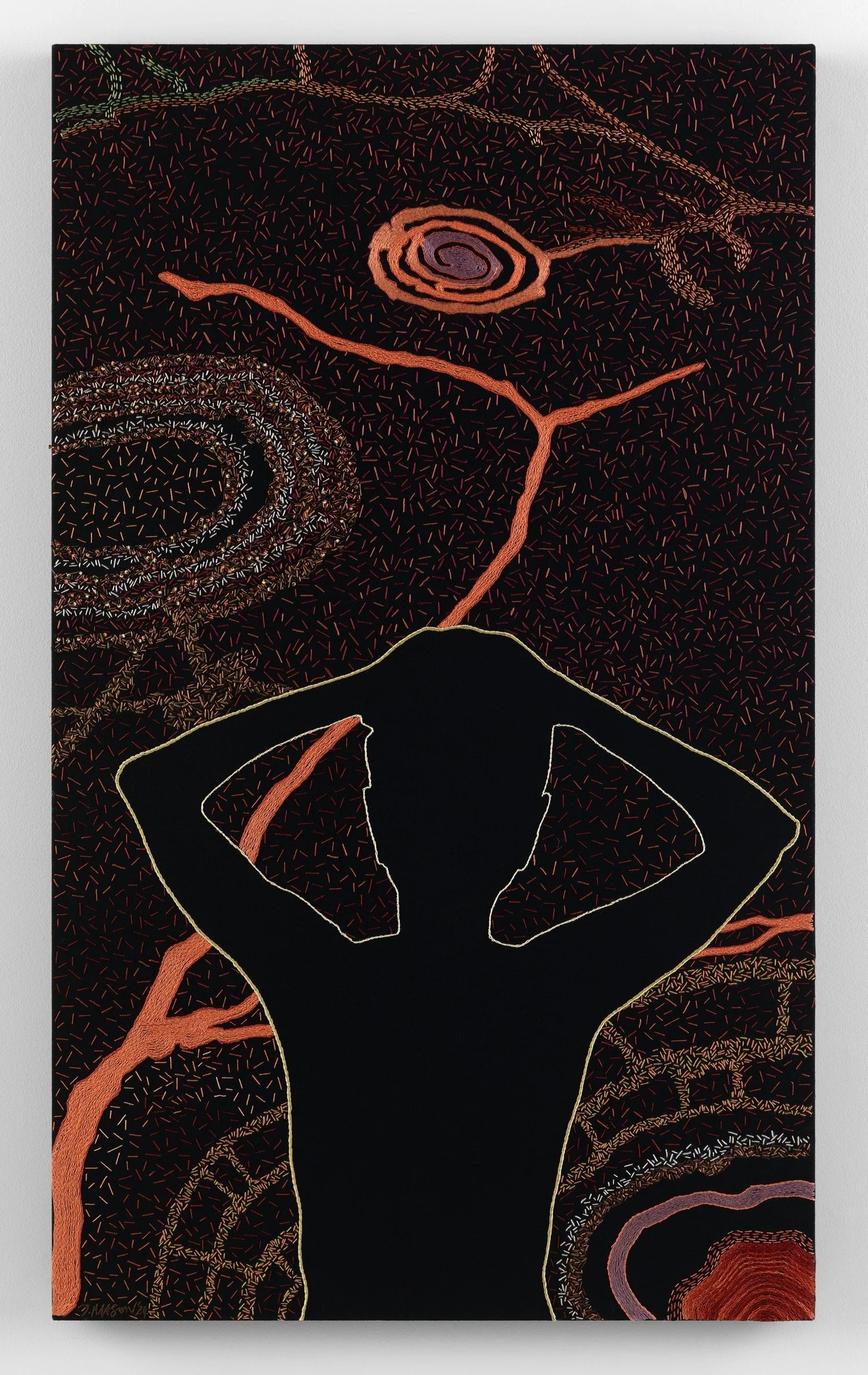Seeing Shadows 2024/25
Walking through the veld and stitching are repetitive, meditative actions that ground me. As I walk, my shadow falls on earth, rocks and grasslands where other women’s shadows have fallen for millennia. My shadow becomes a connection with theirs. Our shadows are transient, temporary and leave no traces. In the rock paintings and engravings of Southern Africa, forms of animals, humans and abstract phenomena are “reduced” to silhouettes, shadows of the people and animals that were once present. A way of communicating across millennia and cultures with imagery, where we create meaning from what we see using our contexts and understanding.
Our actions also create “shadows” that fall on others and the environment. Left unchecked, the powerful in society often destroy the marginalised.
The artworks are arranged with a full image and detailed sections below it. Photographing work on black fabric is tricky; the close-up details provide a full sense of the work.
The impetus for this image came from a reflection of my son in a rock pool on a granite outcrop.
“reflection noun (SHOW)
something that shows, expresses, or is a sign of something
reflection noun (IMAGE)
the image of something in a mirror or any reflective surface
reflection noun (SENDING BACK)
physics specialised: the return of light, heat, sound or energy from a surface
reflection noun (SIGN)
a sign or result of something
reflection noun (THOUGHT)
serious and careful thought”
— Cambridge Dictionary
Every day of the six weeks that it took to make this piece, the word reflection and the need to reflect on how we interact with our environment played on a loop in my head. The many meanings of reflection align well with this meditation.
Reflection
Embroidery on fabric
147 x 89 cm
Available from Pippy Houldsworth Gallery, London
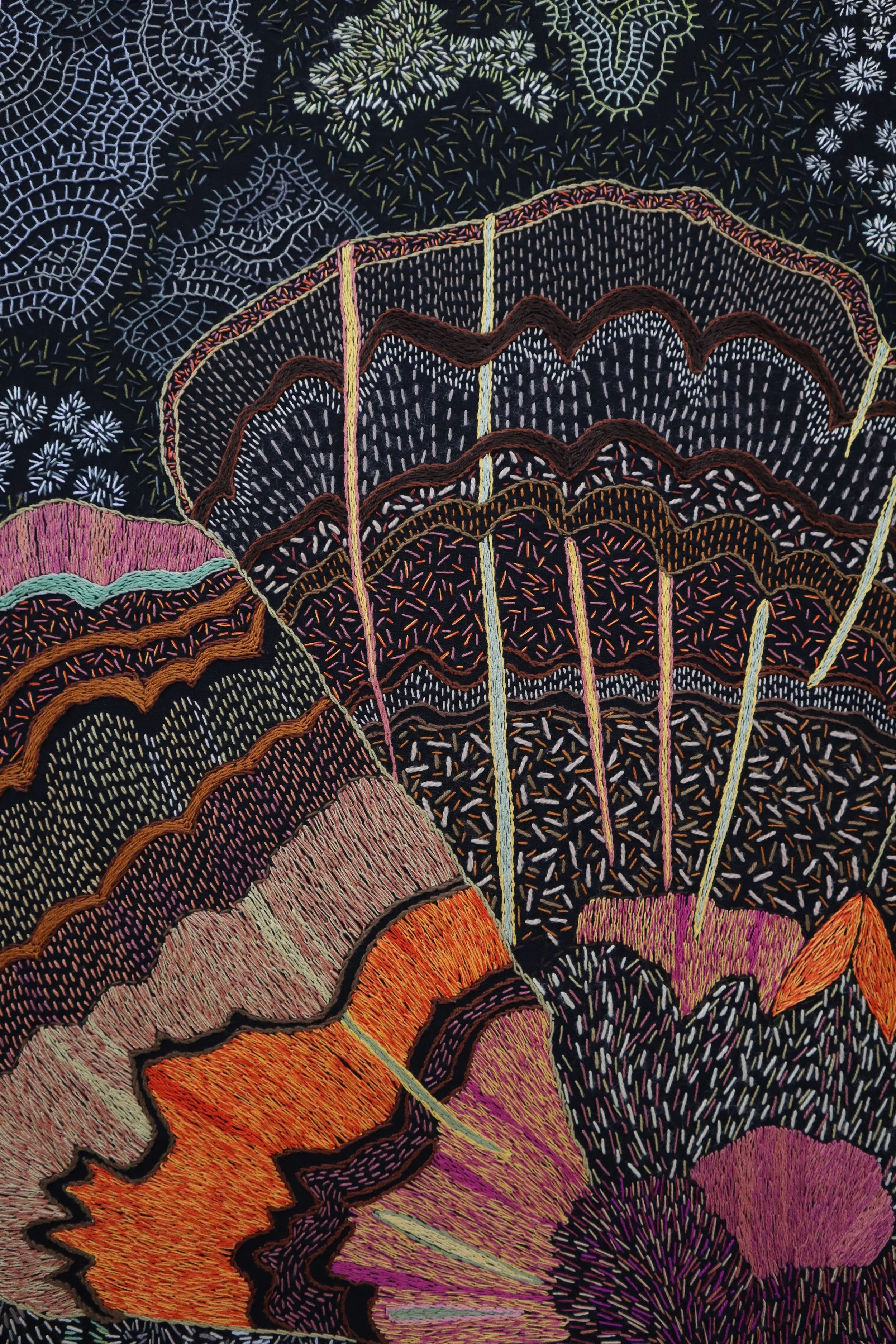


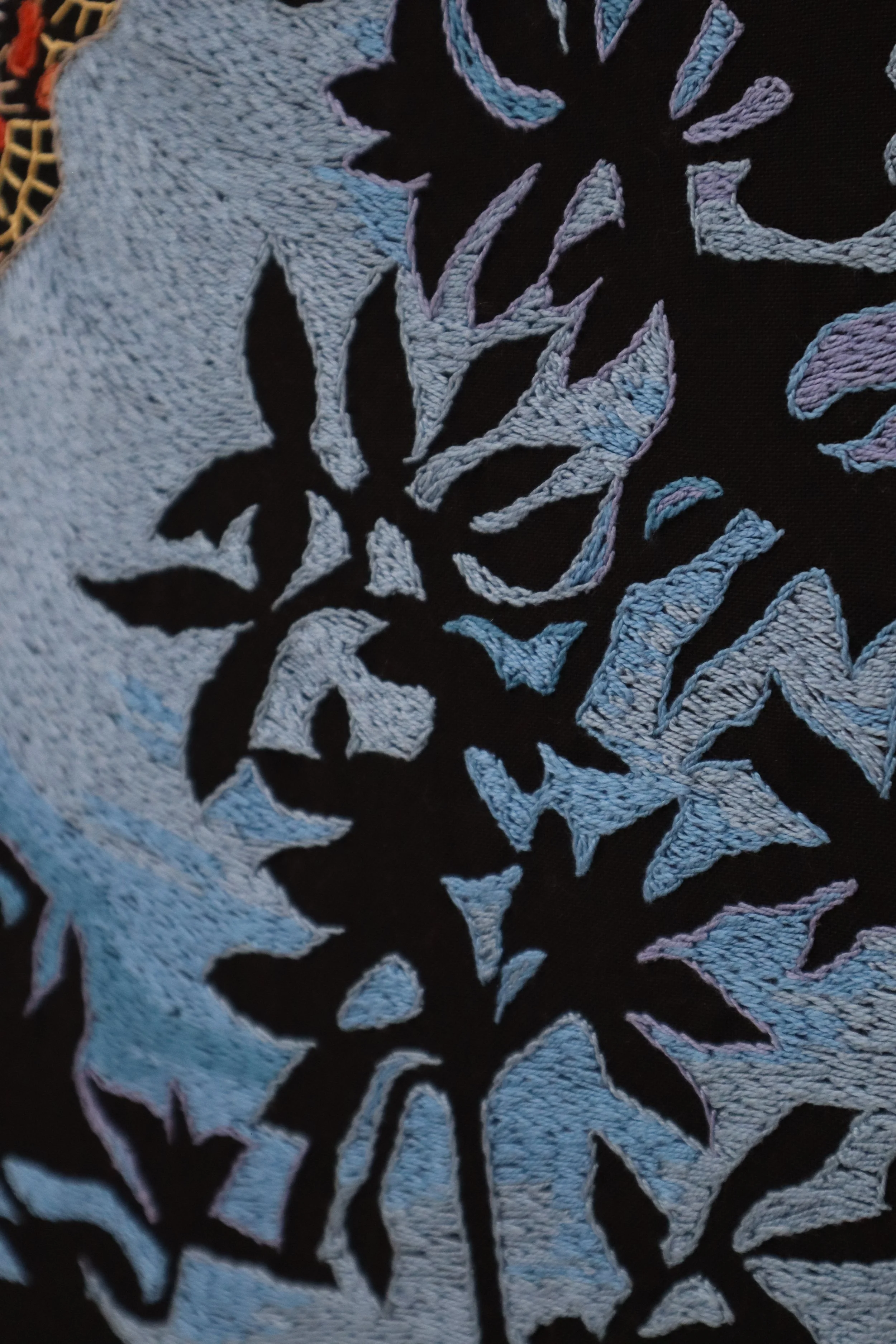
Valley is based on the Treur/Sefogwane Valley. Lying south of the Blyde Canyon in the Mpumalanga escarpment, this valley is one of the most beautiful I have walked through and contains an incredible, fragile diversity of plants and insects. The insect is a shimmering shield bug that favours Lasiosiphon plants; the two-meter-high Drimia altissima plants are medicinal and highly toxic. The embroidered lichen of the rocks is an indicator of clean air becoming a kimono-like cloak for my shadow.
Valley
Embroidery on fabric
190 x 123 cm
Private collection, South Africa




Since 2023, I have been part of a group going up to the Mpumalanga escarpment to cut down invasive, alien pine trees. The pines are threatening grasslands, which are incredibly rich and diverse in indigenous plant species. Pine trees from Mexico and the USA supply timber for the extractive mining industry in South Africa. More than 70% of the natural biodiverse grassland landscape of the region is covered in plantations, causing multiple species to become critically endangered and extinct. The grasslands serve as a catchment, provide water for areas below the mountains, and are massive carbon sinks. They regulate temperature and keep things in balance (like a fan). Gladious eklonii is found in the grasslands, and the shadow figure references female ties to the earth.
Escarpement
Embroidery on fabric
190 x 123 cm
Available from Pippy Houldsworth Gallery, London




Puff adders are an indicator species; in Mpumalanga, their presence indicates the ecosystem is balanced. Brachystelma are a group of plants used as a source of food and medicine in southern Africa. A walking meditation on the importance of local environments.
Indicator
Embroidery and beads on fabric
211.5 x 88.5 cm
Available from Pippy Houldsworth Gallery, London




In the mountains and valleys of Mpumalanga, thousands of illegal artisanal miners, or Zama Zamas (Zama is the isiZulu word for attempt or try), dig in rivers and mountainsides or reopen disused mine shafts to mine gold. With formal mines shedding thousands of jobs, skilled miners destroy swathes of pristine wild areas. They live on the fringes of society, often as illegal immigrants without access to limited state resources, selling the gold that they mine to criminal syndicates that launder it into the formal gold trade.
Walking in the mountains, I have been coming across traces that they have left on the landscape, in a sense, shadows that suggest who they are and what they do. Amongst these are the Remington Gold cigarette boxes, smuggled by the millions into South Africa from Zimbabwe (and a conceptual gift), a bag of coarse salt used in combination with tartaric acid in the final process of cleaning gold, cheap penlight batteries for headlamps, cut off duiker hooves from poaching for food, empty bottles of pure glycerine and potassium permanganate and a empty box of cheap coffee.
These miners highlight the failure of southern African states to create safe, sustainable employment for their citizens and the resulting destruction of our heritage and environment. The road map that holds this piece together is of the areas where I found the traces.
Traces
Embroidery and beadwork on fabric
215 x 88 cm
Available through the Pippy Houldsworth Gallery (London)




Blanket is based on the style of blankets known as Basotho Blankets. The size of the piece is the same as the commercially available blankets, which are worn as an item of protective “clothing” by Basotho people, and that became globally famous with the Black Panther movie. The text “Thonatho hae hole, retsamaya marung, bontate lona lereng” is Southern Sotho for “lightning doesn’t grow, we walk in the clouds, you men/fathers, what are you saying”. Basotho oral poetry is grouped into three main areas: Dithoko (praise poems), Diboko (family odes) and Difela ‘Mineworkers’ chants. This text was written in blue crayon in a rock shelter where Zama Zama’s or illegal artisanal miners, were living. The crayon partially covered hundreds of years-old San rock paintings. These miners are 800 kilometres from their homes in Lesotho.
Zama Zama Blanket
Embroidery on fabric
160 x 165 cm
Available from Pippy Houldsworth Gallery, London




Leopards Cloak is based on an unfinished painting in my mother’s studio that I found after she died. On a preparatory sketch for the painting, she had written “Yoruba death leopard – beautiful death who puts on a spotted robe when he goes to his victim”. The Art Deco porcelain ginger jar was in my grandmother’s house when she died, and was a favourite of my mother’s during her difficult childhood. The other two jars my mother collected. The three jars are now in my house and form a fragile connection to my maternal line. The piece is a tribute to my mother, whose work has become a shadow for me.
Leopard's Cloak
Embroidery on fabric
155.5 x 106.5 cm
Available from Pippy Houldsworth Gallery, London

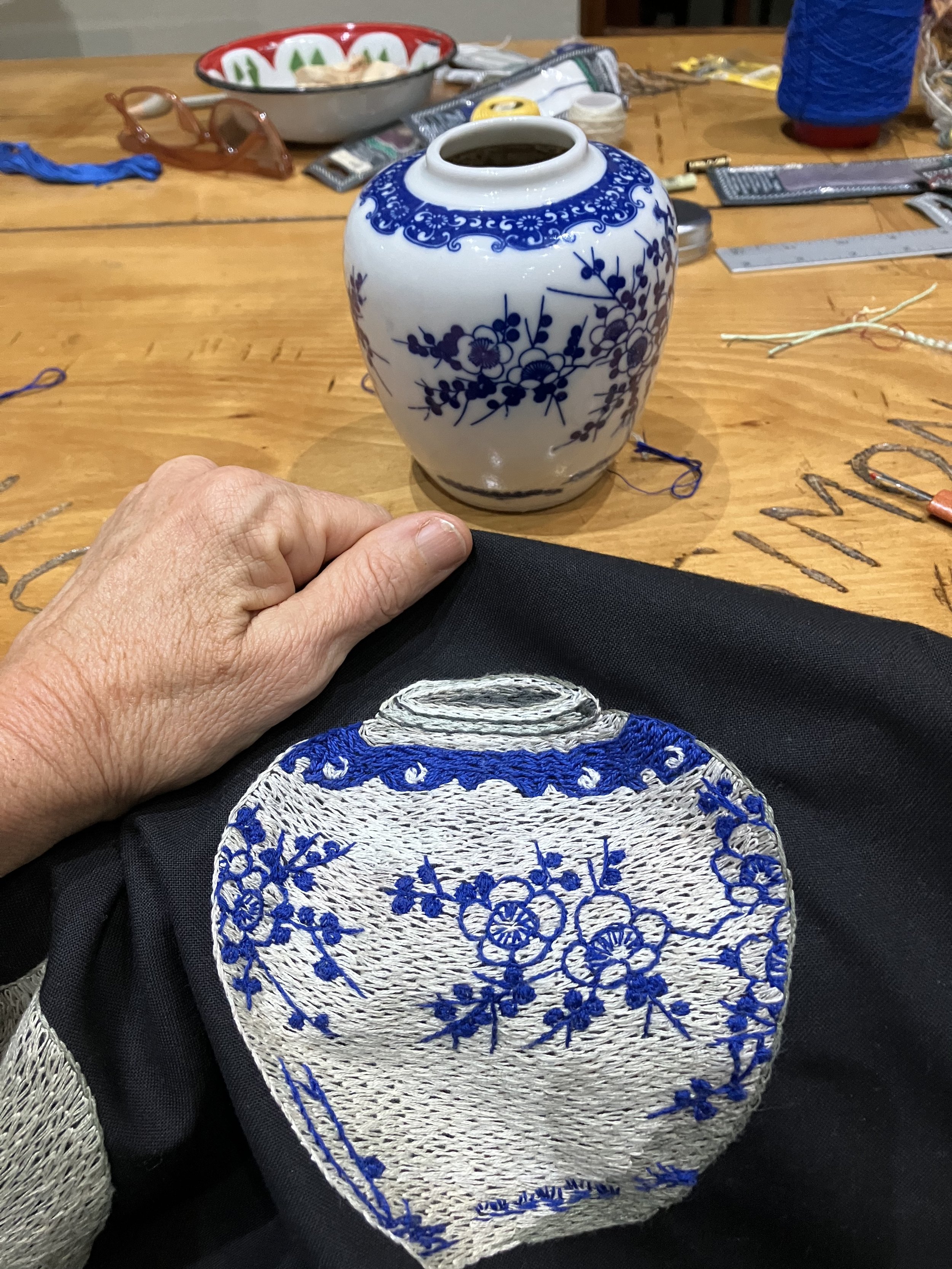


“Make” is a play on words; in Siswati make means mother. The “shadow” image for this was a photograph of my mother that I took at sunset in the Central Kalahari with her holding a wildebeest skull above her head. My mother was an artist, a maker and likewise I am. The background “roads” are based on termite pathways, and the cicada is from my garden. Both termites and cicadas emerge from below ground, in a similar way to how ideas emerge from the subconscious make/mother.
Make
Embroidery and beadwork on fabric
213 x 88.5 cm
Available from Pippy Houldsworth Gallery, London




Shadow Hands. The image of shadow hands came to me while driving into town for grocery shopping towards the end of 2023. The disturbing images of war in Gaza and Sudan were going around and around in my head. Shadow hands is a play on words, the shadowy hands behind the scenes fuelling global conflict as women resist the destruction of their homes and communities. Putting their hands up and forward in a “stop” gesture. But like a shadow, a fleeting moment of strength before disappearing.
Shadow Hands
Embroidery on fabric
100 x 60 cm
Available from Pippy Houldsworth Gallery, London




For thousands of years, people have left tantalising marks and images on the southern African landscape. Engraved into rock and painted on smooth rock surfaces, these images communicate with us in a profoundly creative human way but simultaneously remain frustratingly opaque. We are transformed by them.
Tranceform
Embroidery, glass and ostrich eggshell beads on fabric
101 x 61 cm
Available from Pippy Houldsworth Gallery, London

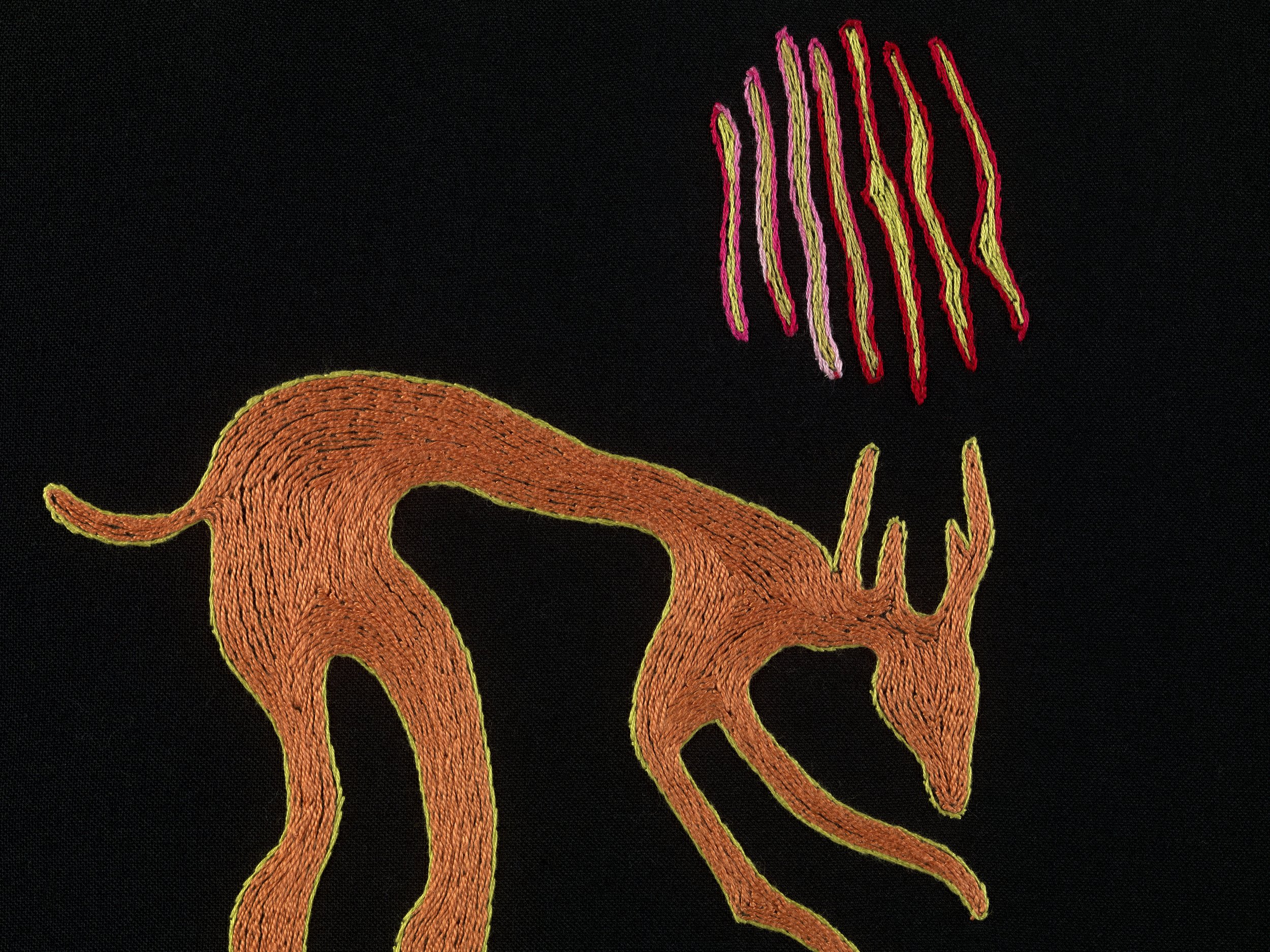


iShadow is a play on how we see and construct images of ourselves.
iShadow
Embroidery and beadwork on fabric
100.5 x 60 cm
Available from Pippy Houldsworth Gallery, London




The Seven Sisters and Orion are used by humans to find the true South. Moths navigate using the stars and the moon. Morning Song by Sylvia Plath most accurately describes what I felt when my children were infants, with their moth breath. My daughter is now in her mid-20s, navigating the impossible world my generation has helped create.
Navigation
Embroidery and beads on fabric
208 x 128 cm
Private collection, Italy




The porcelain fragments are from shipwrecks along the East African coast, as are the carnelian beads and the cowrie shells. The porcelain, the carnelian beads and cowrie shells that I found are from Portuguese ships wrecked in 1554 and 1608 along the Eastern Cape coast. The carnelian beads were made in India and were used as rosaries and for trading slaves. The cowries were used as currency and are not African but are from Indonesia. This piece is a meditation on the remnants of trade, dreaming and the relationship between East Africa and Asia now and in the past. I have included appliqué (one of my capulanas from Mozambique) and beadwork in this work. The past shadows what happens in the present.
Tides
Embroidery, beadwork and appliqué on fabric
257 x 128 cm
Available from Pippy Houldsworth Gallery, London




